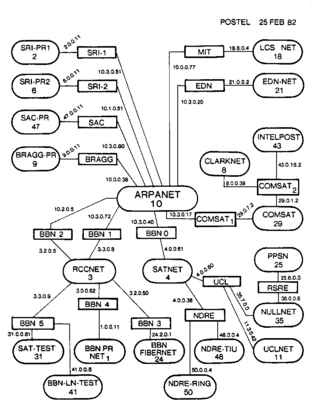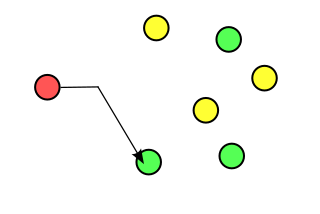Related Research Articles
The Dynamic Host Configuration Protocol (DHCP) is a network management protocol used on Internet Protocol (IP) networks for automatically assigning IP addresses and other communication parameters to devices connected to the network using a client–server architecture.
An Internet Protocol address is a numerical label such as 192.0.2.1 that is assigned to a device connected to a computer network that uses the Internet Protocol for communication. IP addresses serve two main functions: network interface identification, and location addressing.

Internet Protocol version 4 (IPv4) is the fourth version of the Internet Protocol (IP). It is one of the core protocols of standards-based internetworking methods in the Internet and other packet-switched networks. IPv4 was the first version deployed for production on SATNET in 1982 and on the ARPANET in January 1983. It is still used to route most Internet traffic today, even with the ongoing deployment of Internet Protocol version 6 (IPv6), its successor.

Internet Protocol version 6 (IPv6) is the most recent version of the Internet Protocol (IP), the communications protocol that provides an identification and location system for computers on networks and routes traffic across the Internet. IPv6 was developed by the Internet Engineering Task Force (IETF) to deal with the long-anticipated problem of IPv4 address exhaustion, and was intended to replace IPv4. In December 1998, IPv6 became a Draft Standard for the IETF, which subsequently ratified it as an Internet Standard on 14 July 2017.
Classless Inter-Domain Routing is a method for allocating IP addresses for IP routing. The Internet Engineering Task Force introduced CIDR in 1993 to replace the previous classful network addressing architecture on the Internet. Its goal was to slow the growth of routing tables on routers across the Internet, and to help slow the rapid exhaustion of IPv4 addresses.
A multicast address is a logical identifier for a group of hosts in a computer network that are available to process datagrams or frames intended to be multicast for a designated network service. Multicast addressing can be used in the link layer, such as Ethernet multicast, and at the internet layer for Internet Protocol Version 4 (IPv4) or Version 6 (IPv6) multicast.
The Routing Information Protocol (RIP) is one of the oldest distance-vector routing protocols which employs the hop count as a routing metric. RIP prevents routing loops by implementing a limit on the number of hops allowed in a path from source to destination. The largest number of hops allowed for RIP is 15, which limits the size of networks that RIP can support.

A subnetwork, or subnet, is a logical subdivision of an IP network. The practice of dividing a network into two or more networks is called subnetting.

A classful network is an obsolete network addressing architecture used in the Internet from 1981 until the introduction of Classless Inter-Domain Routing (CIDR) in 1993. The method divides the IP address space for Internet Protocol version 4 (IPv4) into five address classes based on the leading four address bits. Classes A, B, and C provide unicast addresses for networks of three different network sizes. Class D is for multicast networking and the class E address range is reserved for future or experimental purposes.
Bogon filtering is the practice of filtering bogons, which are bogus (fake) IP addresses of a computer network. Bogons include IP packets on the public Internet that contain addresses that are not in any range allocated or delegated by the Internet Assigned Numbers Authority (IANA) or a delegated regional Internet registry (RIR) and allowed for public Internet use. The areas of unallocated address space are called the bogon space.

Anycast is a network addressing and routing methodology in which a single IP address is shared by devices in multiple locations. Routers direct packets addressed to this destination to the location nearest the sender, using their normal decision-making algorithms, typically the lowest number of BGP network hops. Anycast routing is widely used by content delivery networks such as web and name servers, to bring their content closer to end users.
A broadcast address is a network address used to transmit to all devices connected to a multiple-access communications network. A message sent to a broadcast address may be received by all network-attached hosts.
In computer networking, localhost is a hostname that refers to the current computer used to access it. The name localhost is reserved for loopback purposes. It is used to access the network services that are running on the host via the loopback network interface. Using the loopback interface bypasses any local network interface hardware.
In the Internet addressing architecture, the Internet Engineering Task Force (IETF) and the Internet Assigned Numbers Authority (IANA) have reserved various Internet Protocol (IP) addresses for special purposes.
In computer networking, a link-local address is a network address that is valid only for communications on a local link, i.e. within a subnetwork that a host is connected to. Link-local addresses are most often unicast network addresses assigned automatically through a process known as stateless address autoconfiguration (SLAAC) or link-local address autoconfiguration, also known as automatic private IP addressing (APIPA) or auto-IP. Link-local addresses are not all unicast; e.g. IPv6 addresses beginning with ff02:, and IPv4 addresses beginning with 224.0.0. are multicast addresses that are link-local.
A unique local address (ULA) is an Internet Protocol version 6 (IPv6) address in the address range fc00::/7. These addresses are non-globally reachable. For this reason, ULAs are somewhat analogous to IPv4 private network addressing, but with significant differences. Unique local addresses may be used freely, without centralized registration, inside a single site or organization or spanning a limited number of sites or organizations.
The Internet Protocol Version 4 address 0.0.0.0 can have multiple uses.

An Internet Protocol version 6 address is a numeric label that is used to identify and locate a network interface of a computer or a network node participating in a computer network using IPv6. IP addresses are included in the packet header to indicate the source and the destination of each packet. The IP address of the destination is used to make decisions about routing IP packets to other networks.
In order to ensure proper working of carrier-grade NAT (CGN), and, by doing so, alleviating the demand for the last remaining IPv4 addresses, a /10 size IPv4 address block was assigned by Internet Assigned Numbers Authority (IANA) to be used as shared address space. This block of addresses is specifically meant to be used by Internet service providers that implement carrier-grade NAT, to connect their customer-premises equipment (CPE) to their core routers.
References
- 1 2 Y. Rekhter; B. Moskowitz; D. Karrenberg; G. J. de Groot; E. Lear (February 1996). Address Allocation for Private Internets. Network Working Group. doi: 10.17487/RFC1918 . BCP 5. RFC 1918.Best Common Practice. Obsoletes RFC 1627 and 1597. Updated by RFC 6761.
- 1 2 3 R. Hinden; B. Haberman (October 2005). Unique Local IPv6 Unicast Addresses. Network Working Group. doi: 10.17487/RFC4193 . RFC 4193.Proposed Standard.
- ↑ Forouzan, Behrouz (2013). Data Communications and Networking. New York: McGraw Hill. pp. 530–31. ISBN 978-0-07-337622-6.
- 1 2 J. Weil; V. Kuarsingh; C. Donley; C. Liljenstolpe; M. Azinger (April 2012). IANA-Reserved IPv4 Prefix for Shared Address Space. Internet Engineering Task Force. doi: 10.17487/RFC6598 . ISSN 2070-1721. BCP 153. RFC 6598.Best Common Practice. Updates RFC 5735.
- ↑ C. Huitema; B. Carpenter (September 2004). Deprecating Site Local Addresses. Network Working Group. doi: 10.17487/RFC3879 . RFC 3879.Proposed Standard.
- ↑ M. Cotton; L. Vegoda; B. Haberman (April 2013). R. Bonica (ed.). Special-Purpose IP Address Registries. IETF. doi: 10.17487/RFC6890 . ISSN 2070-1721. BCP 153. RFC 6890.Best Common Practice. Obsoletes RFC 4773, 5156, 5735 and 5736. Updated by RFC 8190.
- 1 2 S. Cheshire; B. Aboba; E. Guttman (May 2005). Dynamic Configuration of IPv4 Link-Local Addresses. Network Working Group. doi: 10.17487/RFC3927 . RFC 3927.Proposed Standard.
- ↑ R. Hinden; S. Deering (February 2006). IP Version 6 Addressing Architecture. Network Working Group. doi: 10.17487/RFC4291 . RFC 4291.Draft Standard. Obsoletes RFC 3513. Updated by RFC 5952, 6052, 7136, 7346, 7371 and 8064.
- ↑ S. Thomson; T. Narten; T. Jinmei (September 2007). IPv6 Stateless Address Autoconfiguration. Network Working Group. doi: 10.17487/RFC4862 . RFC 4862.Draft Standard. Obsoletes RFC 2462. Updated by RFC 7527.